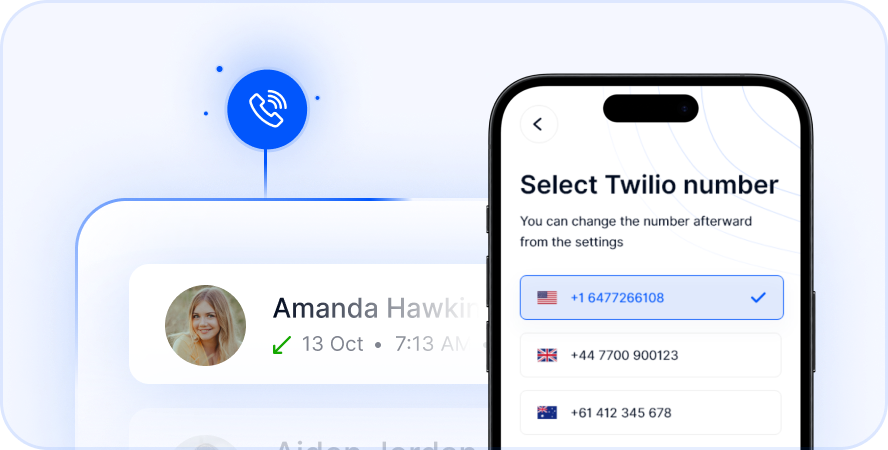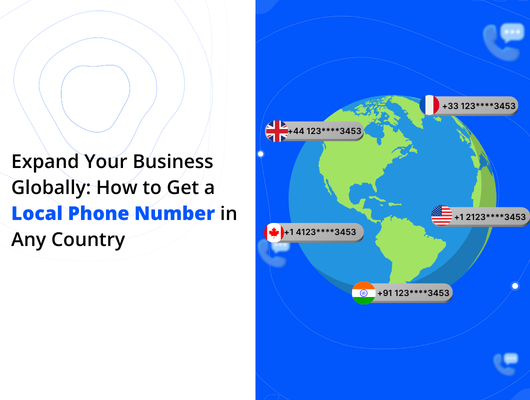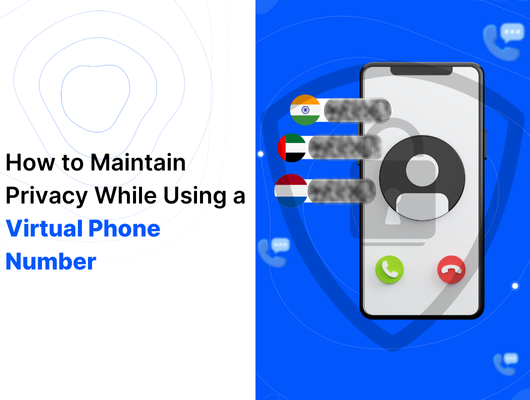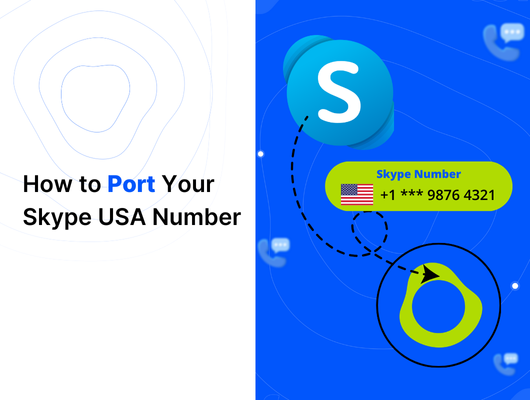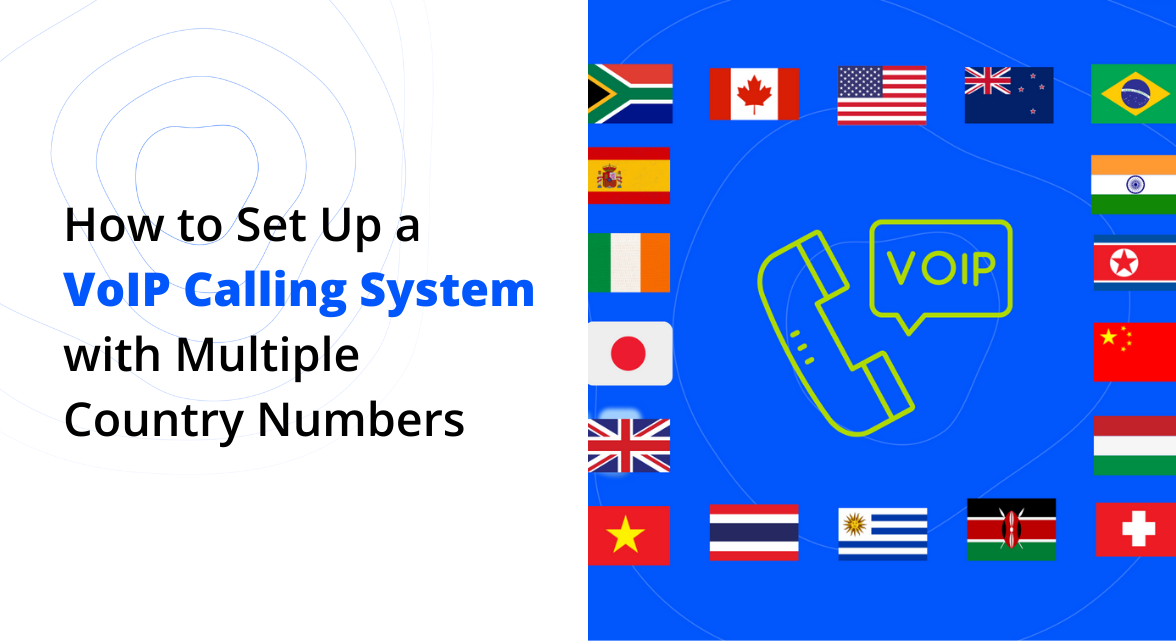
Growing your business globally means connecting with people everywhere. In today’s digital world, talking to clients in different countries easily is essential for success. Whether you have a small team or a large company, setting up a VoIP calling system way using virtual numbers in multiple countries can make your communication much smoother and help your business grow.
Forget the old way of needing expensive phone lines in every country. Thanks to VoIP (Voice over Internet Protocol) technology, you can now get virtual phone numbers for many different countries. You can manage all these numbers from one system, typically accessed online. This makes it simple and cost-effective to build a local presence around the world. To learn more about VoIP technology and how it works, you can read this detailed guide on how VoIP works. This blog will explain how to set up this kind of system, what you need, and how it can change your international business communication.
Why Your Business Needs Multiple Country Numbers
Having phone numbers in different countries gives your business a significant advantage. It helps you appear local to customers even if your main office is far away. This approach builds trust and makes communication easier for everyone involved.
Establishing Local Presence Globally
When you have a local phone number in a country, customers there see you as part of their community. This makes them more likely to trust your business. It feels more personal and accessible than calling an international number.
Enhancing Customer Experience
Customers can call you using a local number. This means they do not pay high international calling fees. Making it easy and cheap for customers to reach you greatly improves their experience with your business.
Boosting Operational Efficiency
Managing calls from different countries becomes much simpler. All calls come through one central system. Your team can handle calls from various regions efficiently, without needing separate phone setups for each location. This streamlines your operations.
Significant Cost Savings
You do not need physical phone lines or expensive international call plans. VoIP uses the internet for calls, which is much cheaper. Setting up and maintaining virtual numbers is also significantly less expensive than traditional phone lines.
These benefits show why having a VoIP system with numbers in multiple countries is crucial for international business growth.
Step-by-Step Guide to Setting Up Your System
Setting up your multi-country VoIP system involves several key steps. Following these steps ensures your system is effective, reliable, and meets your business needs.
Step 1: Choosing the Right VoIP Provider
Selecting the right service provider is the first and most important step. Not all VoIP providers offer virtual numbers in many different countries. You need to find one that supports your target markets.
Here are key factors to consider when choosing a provider:
- Global Coverage: Check if they offer local numbers in all the countries you need. A wider reach gives you more flexibility.
- Scalability: Your provider should be able to easily add more numbers or users as your business grows internationally.
- Feature Set: Look for features like call forwarding, auto-attendant, call recording, and voicemail. These are important for managing international calls.
- Reliability and Support: Since calls rely on the internet, a stable service and responsive customer support are essential.
- Compliance: Ensure the provider helps you meet data privacy regulations in the countries where you operate.
A good provider makes setting up and managing numbers in multiple countries straightforward.
Step 2: Acquiring and Configuring Virtual Numbers
Once you have chosen a provider, you can start getting the virtual numbers you need. These numbers will connect your business to your target countries.
- Identify Target Markets: Decide which countries are most important for your business. Focus on where your customers are or where you plan to expand soon.
- Purchase Numbers: Your VoIP provider will guide you through buying virtual numbers for these countries. They are linked to your main phone system.
- Set Up Call Routing: Plan how incoming calls should be directed. You can send calls from specific countries to certain departments or individuals based on your business structure.
- Localize Greetings: Record voicemails and greetings in the local language of each country. This makes your business feel welcoming and professional to callers.
Virtual numbers allow you to expand your reach without opening physical offices everywhere.
Step 3: Integrating with Existing Business Tools
Connecting your VoIP system with tools like your CRM (Customer Relationship Management) system is very important for businesses. Integration helps you manage customer interactions better and improves teamwork.
- Gain Customer Insights: See call history and customer notes directly in your CRM. This gives your team a full picture of each customer relationship.
- Improve Support: Easily manage customer questions from different regions. Your support team has access to relevant information quickly, leading to faster help.
- Boost Sales and Marketing: Sales teams can track international leads and follow up more effectively using integrated tools.
- Automate Processes: Set up automatic actions based on calls, such as sending follow-up emails. This improves engagement with international clients.
Integration makes your business more efficient and helps you respond better to customer needs worldwide.
Step 4: Leveraging Advanced International Features
VoIP systems offer many features that make international calls easier to manage. Configuring these features helps you provide excellent service across different regions and time zones.
- Call Forwarding: Automatically send calls from one country’s number to another location or person. For example, calls to your German number could forward to a team member in Spain.
- Auto-Attendant (IVR): Use an automated menu system to direct callers to the right department or person. You can customize options based on the caller’s location or language.
- Call Recording: Record conversations for quality checks, training, or compliance. This is useful for reviewing interactions across different languages and cultures.
- Voicemail to Email/Text: Get voicemails transcribed and sent to your email or phone as text. This ensures you do not miss important messages from different time zones.
- Time Zone Management: Configure call routing and availability based on the local time zones of your target countries.
Using these features helps your business stay available and responsive to clients no matter where they are located.
Finding the Right Partner: Introducing Telfon
When you are ready to set up a VoIP system with numbers in many countries, choosing the right partner is important. A platform like Telfon can simplify this process. Telfon offers cloud telephony solutions designed to handle international communication needs for businesses and individuals.
Telfon provides virtual numbers and calling services in over 180 countries, helping you establish a wide global presence. Its features include call recordings, voicemail to text, and WhatsApp integration, which are valuable for connecting with international contacts. The platform is designed to be easy to use and scalable, fitting the needs of various businesses looking to manage calls and messages across multiple regions efficiently.with ease.
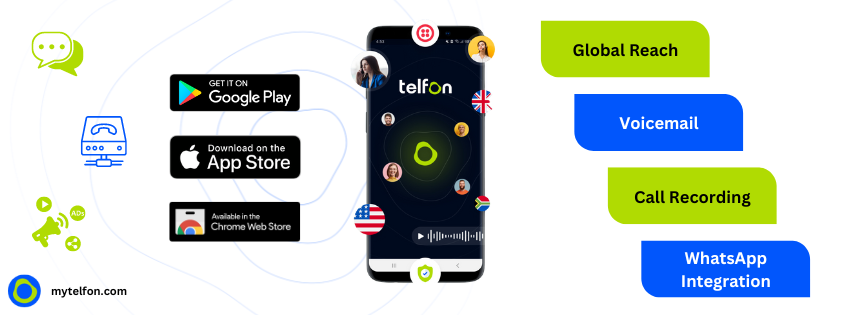
Step 5: Ensuring Security and Compliance
Protecting data and following international rules is crucial when handling calls from different countries. Every country might have its own laws about data privacy and communication.
- Call Encryption: Make sure your VoIP provider encrypts calls and data. This protects sensitive information and prevents unauthorized access.
- Data Storage Rules: Some countries require that customer data stays within their borders. Check if your provider can meet these data localization requirements.
- Regular Audits: Periodically check your system and practices to ensure they meet current international regulations. Staying compliant is key to avoiding legal issues.
Understanding and meeting these requirements is vital for operating ethically and legally worldwide.
Step 6: Monitoring and Optimizing Performance
Once your system is active, continuously watching how it works helps ensure smooth operations. You can find areas for improvement and make sure everything is running efficiently.
- Analyze Call Data: Look at call volume, how many calls are missed, and how quickly calls are answered for each country’s number. This data shows you what is working well and what needs attention.
- Gather Customer Feedback: Ask your international customers about their calling experience. Their input can highlight any problems or areas where you can do better.
- Adjust Routing: As your business or call patterns change, update your call routing. Make sure calls are always directed to the best person or team.
- Plan for Growth: As you expand into new markets, be ready to add more country numbers and increase your system’s capacity.
Ongoing monitoring helps keep your international communication system effective and aligned with your business go
Frequently Asked Questions
Q1. What is a virtual phone number?
A virtual phone number is a phone number not tied to a specific physical location or line. It exists in the cloud and can forward calls to any phone or device connected to the internet.
Q2. How quickly can I get a virtual number in another country?
In most cases, you can purchase and activate a virtual number for another country within minutes through your VoIP provider’s online portal.
Q3. Can I use my existing phone hardware with a multi-country VoIP system?
Yes, many VoIP systems work with standard desk phones (if they are VoIP-enabled) or through softphone apps on computers and smartphones.
Q4. Is the call quality good for international calls using VoIP?
Call quality depends on your internet connection speed and the quality of your VoIP provider’s network. With a stable connection, VoIP call quality can be excellent, often better than traditional international calls.
Q5. How do I manage calls coming into different country numbers?
Your VoIP system’s dashboard or control panel lets you configure how calls are routed, set up auto-attendants, and manage other features for each number.
Setting up a VoIP system with multiple country numbers is a smart move for any business aiming for global reach. It allows you to build local connections, improve efficiency, and save costs. By selecting a reliable provider and following the steps outlined, you can create a robust communication system that supports your international growth and helps you connect with customers and partners around the world with ease.



